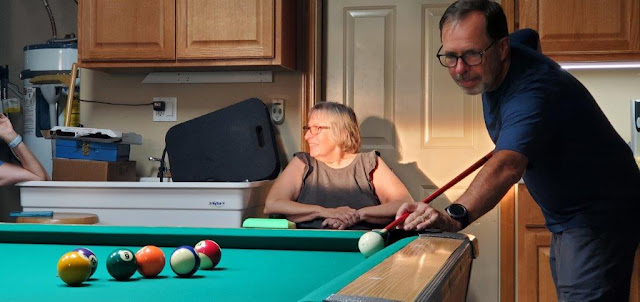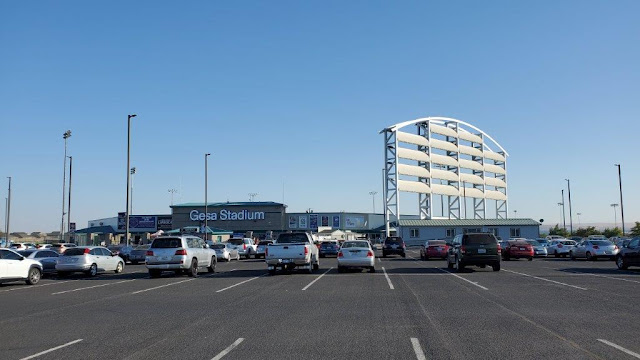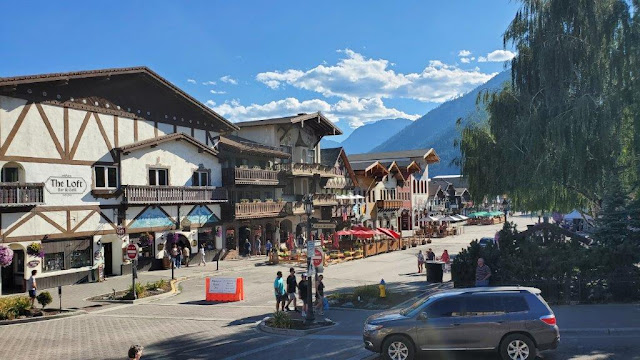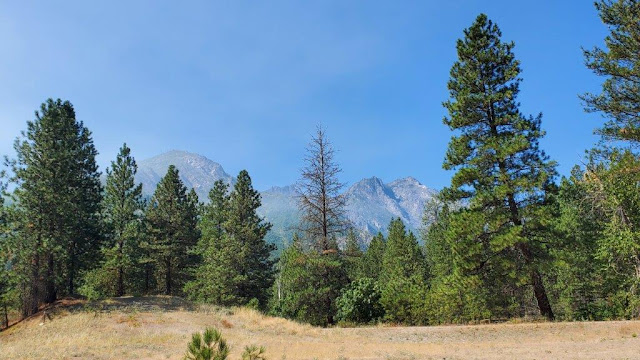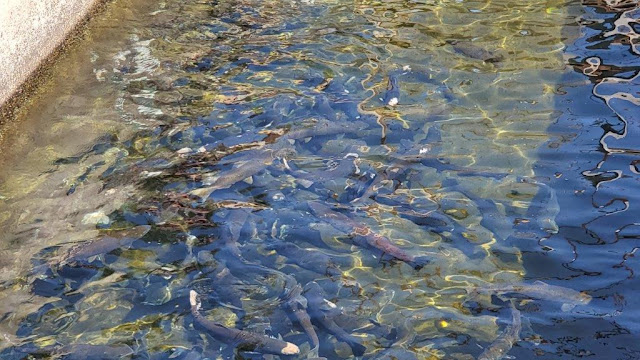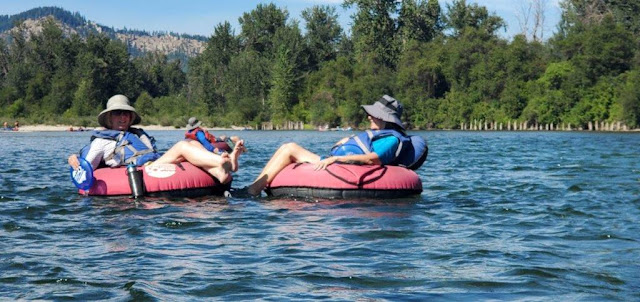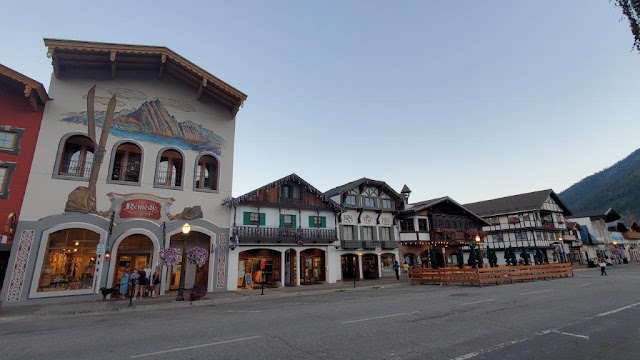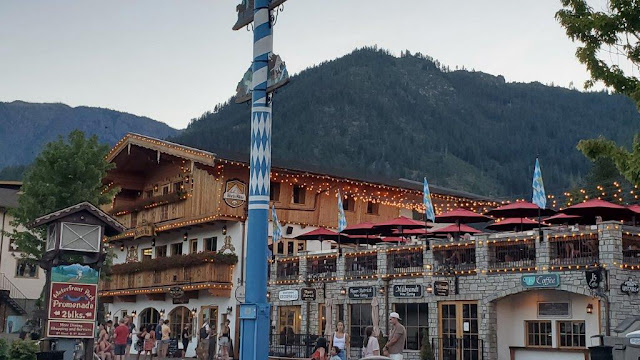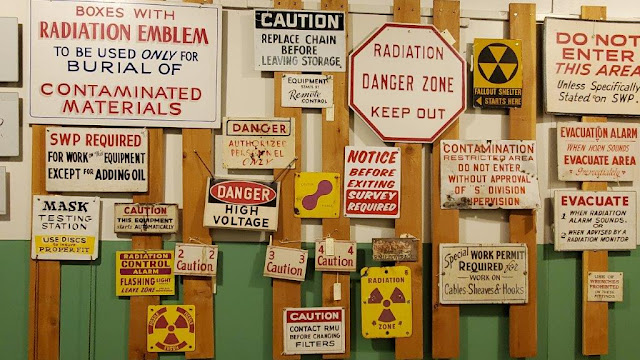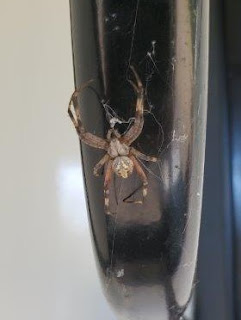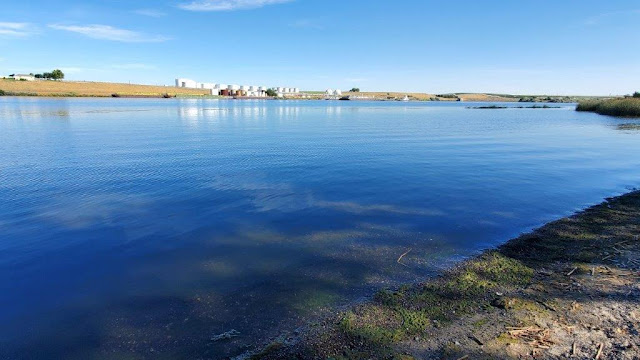We left Crescent Bar, Washington after a one night stay to meet up with our good friends, Linda & Randy who were camp hosting at Hood Park in Pasco, Washington for the summer. Hood Park is a Corp of Engineer (COE) park where the Snake and Columbia Rivers meet. I booked this campground way in advance and picked a site near the park camp hosts and got lucky to be right next to our friends.
 |
| Hood Park COE and Campground from across the Snake River |
 |
| We got to play more Mexican Train with Linda and Randy |
While we were visiting with Linda and Randy, we did some side trips. One was to Palouse Falls.
 |
| Rylee joined us for this day trip to the falls. |
 |
| Looking downstream |
 |
| Looking downstream |
We walked on a trail that took us towards the side of the falls and to an area where we could see the water flowing before the falls.
 |
| The Palouse River on its way to the falls |
 |
| Top of the falls right before in flows over |
 |
| Phew, much needed diesel! |
Side note, unfortunately Diane passed away before Christmas so we were lucky to have met her. She was a neat lady and a big Seattle Mariners fan. I accidentally ended up with one of her Rubbermaid containers so I think of her every time we use it.
The four of us went to Gesa Stadium in Pasco to catch an Everett AquaSox vs. Tri-City Dust Devils baseball game.
 |
| The Tri-Cities Dust Devils beat the Everett AquaSox by a score of 3-2. |
 |
| Mascot, Dusty |
There was a fireworks show after the game.
It was funny that going to two minor league baseball games and we saw the same team, the Everett AquaSox, twice.
The four of us took a road trip to Leavenworth, Washington and stayed at an AirBnB for a few nights.
Leavenworth is a Bavarian-styled village in the Cascade Mountains, in central Washington State. Alpine-style buildings with restaurants serving German beer and food line Front Street. The Nutcracker Museum displays thousands of nutcrackers, some dating back centuries. On the Wenatchee River, Waterfront Park is a habitat for ospreys and eagles. The village is a gateway to nearby ski areas and wineries.
Leavenworth was officially incorporated on September 5, 1906. A small timber community, it became a regional office of the Great Northern Railway in the early 1900s. The railroad relocated to Wenatchee in 1925, greatly affecting Leavenworth's economy. The city's population declined well into the 1950s as the lumber mills closed and stores relocated.
The city looked to tourism and recreation as a major economy as early as 1929, when they opened a ski jump.
In 1962, the Project LIFE (Leavenworth Improvement For Everyone) Committee was formed in partnership with the University of Washington to investigate strategies to revitalize the struggling logging town. The theme town idea was created by two Seattle businessmen, Ted Price and Bob Rodgers, who had bought a failing cafe on Highway 2 in 1960. Price was chair of the Project LIFE tourism subcommittee, and in 1965 the pair led a trip to a Danish-themed town, Solvang, California, to build support for the idea. The first building to be remodeled in the Bavarian style was the Chikamin Hotel, which owner LaVerne Peterson renamed the Edelweiss after the state flower of Bavaria.
We visited the Leavenworth National Fish Hatchery.
The Fish Hatchery raises and releases spring Chinook salmon helping to mitigate for the impact of the Grand Coulee Dam on fish populations.
 |
| Baby salmon pools |
 |
| These guys had a fence that would move along the track to pen the salmon in so they could each be viewed and separated into three areas. 1) Females ready to spawn 2) Males 3) Young salmon |
One by one each fish was examined underneath to determine its category.
 |
| I earned a Junior Fish Biologist badge at this location. |
 |
| The fish either went over the short fence in the foreground, into the square hole in the back or over the wall into the next pool. |
We were fascinated by the process and there was a volunteer nearby that answered all our questions.
Our AirBnB was within walking distance to the downtown which was convenient. One day we went to a restaurant for German food.
 |
| This is how close we were to the bear! |
 |
| Our getting out spot on the right. |
Before leaving the next day we took another walk to downtown to see it in the evening.
 |
| Nutcracker Museum |
Almost since the beginning of time Hanford has been a harsh and arid landscape, plagued by hot summers and high spring winds. For centuries its only inhabitants were Indians who made their winter camps along the banks of the Columbia River.
Eventually the westward expansion brought settlers...ranchers, farmers and storekeepers.
The valley remained peaceful and quiet until the fateful days of 1943 when the U.S. Army Corps of Engineers claimed the land in the name of a secret project known only as the Manhattan Engineering District. Thirty days later the cities of Hanford and White Bluffs ceased to exist. Richland survived, but only as a government town where Manhattan Project officials would live.
 |
| The front face of the plutonium reactor |
 |
| A 3-D Model built to show the B Reactor Core. |
The B Reactor was the first full-scale plutonium production reactor in the world.
There were so many interesting facts to read and observe on this tour. The site was top secret for the dangerous project and safety was a big concern.
The operators of the B Reactor manipulated control rods through this panel to ensure the smooth operation of the reactor. The gauges on the panel and covering the walls of the control room allowed operators to monitor temperature, pressure, and power levels throughout the reactor core. Based on the readings, operators could adjust the control rods to speed up or slow down the reaction, or "SCRAM" the reactor - shutting it down in case of emergency.
Many instruments on the control panel were built onsite and had never been used in an industrial setting prior to the creation of the B Reactor.
 |
| Caution: Bumping panel may cause SCRAM |
 |
| This is a view behind the wall. |
 |
| Leona Harriet Woods, later known as Leona Woods Marshall and Leona Woods Marshall Libby, was an American physicist who helped build the first nuclear reactor and the first atomic bomb. |
 | |
| It was interesting to see these paper Deactivated System tags hanging from variousf pieces of equipment at the plant. |
 |
| I earned another Junior Ranger Badge! |
The tour was very interesting and we would recommend it for anyone in the Hanford, Washington area.
Luckily none of those ugly things got inside the RV!
 |
| Randy, Linda, Nancy, and Al |
 |
| Even Rylee was sad. |
We'll see them again in December at Sunshine Acres in Mesa, AZ for the winter.
Here is the area covered in this entry:
We're continuing south, making our way down the east side of Nevada in the next entry. Thanks for following along......














